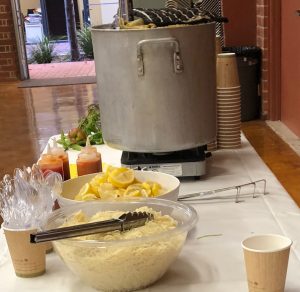Yom Kippur, the holiest day of the Jewish year, takes place this year from the evening of October 8 to the evening of October 9. Yom Kippur is the Day of Atonement, a holiday set aside for prayer and introspection. The laws governing the holiday require Jews to refrain from any kind of work and to afflict their bodies by abstaining from food, water, bathing and sex. The idea is one common to all religions: that by suppressing our physical needs, we will refocus on our spirit.

The giant harira pot on the Nashuva break fast buffet.
Two thousand years ago they called it fasting. Now it’s called cleansing. But the amazing thing is this: it works. By the time the holiday ends, as all Jewish holidays do, at sundown, I feel that something inside me has shifted. Hunger, when it’s a choice, can be empowering, reminding us that we are not captive to any need, impulse or thought.
A day and an hour without food—plus prayers, plus my wife’s sermons— is a way to remind me, as the French philosopher Pierre Teilhard de Chardin said, “We are not human beings having a spiritual experience. We are spiritual beings having a human experience.”
But, then comes the break fast. This is the festive meal that marks the end of the holiday, and in the Ashkenazi Jewish tradition, it can be punitive. The light, healthy being inside you suddenly confronts a groaning board of salty lox, gummed-up cream cheese, oily whitefish, the egg- and sugar-packed baked noodle pudding called kugel, and of course bagels, piles and piles of bagels. Bagels stacked up like barbell weights, bagels that will set anchor in your stomach until the next High Holy Day.
Ashkenazi Jews settled in Central Eastern Europe around the end of the first millennium. Their foods are the foods of their neighbors: bagels, lox, cream cheese, noodle pudding, or kugel, pastrami, corned beef, borscht. When you think deli, think Ashkenazi.
Sephardic Jews took a different route, settling in Spain—the Hebrew word is Sepharad—then fanning out to Portugal, North Africa and the Levant. The foods they adopted or adapted include hummus, couscous, harissa and tagines.
Sephardic cuisine reflects the Mediterranean diet. Meanwhile, no one has written The Ashkenazi Diet. I suppose it’s possible to slim down on nothing but gefilte fish and cheese blintzes, you’d just have to schedule in four hours of Pilates, twice each day.
My people are Ashkenazim, Jews of Eastern European origin. At the turn of the century, my great-grandfather Aaron Eshman went into business with his father-in-law, Louis Peshkin. Eshman and Peshkin opened a kosher restaurant in Chicago, New York Deli, which brought Ashkenazi food to Clark Street. It was called Eshman and Peshkin. It failed.
But I grew up eating on holidays what their menu offered: chicken soup and matzo balls, brisket, kishke and rugalach my maternal grandmother Bertha, and my mother Sari, cooked. It was delicious, and I loved it. But then, in the early 1980’s, I first visited Israel, and discovered the other Jews.
And I liked their food better.
At the end of one Yom Kippur, I was invited to the home of a Moroccan family in Musrara, a neighborhood on the seam between Arab East and Jewish West Jerusalem. The father greeted me at the door with a double kiss, then handed me a shot glass of clear liquid. He motioned for me to toss it down my throat. It was boukha, an eau-de-vie made from figs, and it burned out whatever detritus of the past year was left in my intestinal tract.
Then came harira. This is the traditional dish Sephardic Jews, especially those from North Africa, eat at the end of the fast. It is stew-like, with onions, tomato, rice, lentils, cumin and chile, then finished with lemon juice, parsley and dill. The toasted spices and herbs worked like smelling salts, brought me back to the material world. The lentils quickly filled me up without weighing me down. The touch of hot chile pepper rekindled my appetite. Kugel was dead to me.
Years later, I found the recipe. Meme Suissa, the mother of my then-colleague David Suissa, learned to make harira from her grandmother and mother in Casablanca. I spent a day at David’s house while Meme walked me through the steps. The recipe came with reminiscences about how the soup was something the Jews and Muslims shared—the Muslims made it for Ramadan, the Jews for Yom Kippur, and they would often trade recipes and tastes. The idea that a soup could be the bridge between Jews, Muslims and their most sacred holiday makes it tat much more special.
Last year, I decided to make it for my community. My wife, Rabbi Naomi Levy, leads High Holiday services for the congregation she founded, Nashuva. I suggested instead of offering the standard Ashkenazi fare, we go Sephardic.
“Let’s do a break fast,” I told her. “I’ll make harira.”
Naomi announced it to her congregation of 1200 souls. I was on.
I combined Meme’s recipe with inspirations from other cooks, including David Tanis’s recipe and another from TasteofMaroc.com. To cook for a village, it takes a village.
I bought a 15-gallon soup pot from Smart and Final, two feet tall by 1 1/2 feet in diameter. Our friend Julie came over, along with my mother, and we chopped and sautéed 30 onions, added 120 cups of diced tomato, 30 cinnamon sticks, 20 cups of lentils, 120 garlic cloves—you get the idea. I figured just 300 people would stay for the break fast, but that was 300 people who hadn’t eaten in 25 hours.

Julie Drucker and me in the harira kitchen
The holiday ends with the blast of the shofar, the ram’s horn. For me that was a sign: put out the soup. With a small army of volunteers, we stationed the enormous pot alongside bowls of garnishes: lemon wedges, extra virgin olive oil, and fresh chopped parsley. On the other tables, we laid out the cream cheese, white fish and bagels. Because you can only mess with tradition so much.
The congregation spilled into the social hall and in a blink, the food was gone. We received hundreds of compliments on the soup. It was delicious. Also, people were really hungry.
In the midst of the feeding frenzy, an older woman came up to me and said the soup reminded her of celebrating the holiday in her Moroccan grandmother’s home in Paris. There were tears in her eyes.
That, for me, was a spiritual high.

The Nashuva congregation at break fast.
Harira for a Crowd
This recipe serves 20. It can easily be divided or multiplied. (For Nashuva, I multiplied it times fifteen). This version is vegan, though you could replace the water with chicken stock, or even add shreds of cooked chicken, as Meme Suissa does.
- 2 large onions, finely diced, about 4 cups
- 2 cups diced celery and celery leaves
- ½ cup olive oil plus more for garnish
- 8 garlic cloves, minced
- 2 tablespoon dried ginger
- 3 teaspoons black pepper
- 4 teaspoons turmeric
- 2 teaspoon toasted and ground cumin
- 1-2 teaspoons dried red chile flakes
- 2 (3-inch) piece cinnamon stick, ground, or 1/4 teaspoon ground cinnamon
- 8 cups diced ripe tomato, fresh or canned
- 2 T. tomato paste
- Salt
- 4 cup red lentils, rinsed
- 2 cup dried chickpeas, soaked overnight
- Either 1/2 pound angel hair pasta or vermicelli, broken into 1-inch pieces or 6 T. uncooked white rice
Serving Garnishes:
- Lemon wedges, EVOO olive oil, chopped parsley, chopped cilantro, chopped fresh dill, harissa
PREPARATION
- Heat olive oil in a large heavy-bottomed soup pot. Saute onion and celery until softened, about 20 minutes. Add garlic, ginger, pepper, turmeric, cumin, red pepper flakes and cinnamon. Cook until the spices smell fragrant, about 3 minutes.
- Add tomato and tomato paste and bring the mixture to a simmer. Cook, stirring until mixture thickens somewhat, then add 2 1/2 teaspoons salt, lentils and garbanzos. Add 16 cups of water. Bring to a boil, then partially cover and lower to a simmer.
- After one hour, taste for salt, pepper and other spices. Add rice. Cook for another hour, adding more water to keep the consistency like cream. The beans should be very soft.
- Serve, and encourage your guests to garnish the soup with lemon, herbs, harissa and olive oil.